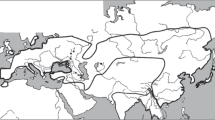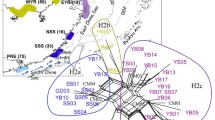Abstract
Genetic and morphological divergence among the four subspecies in the Sebastes pachycephalus complex (S. pachycephalus pachycephalus, S. p. nigricans, S. p. nudus and S. p. chalcogrammus) was clarified. Principal coordinate analysis (PCoA) based on AFLP clearly divided 55 specimens of the complex into two groups, the S. p. pachycephalus–S. p. nigricans group (P-Ni group) and the S. p. nudus–S. p. chalcogrammus group (Nu-C group), although three specimens occupied intermediate positions. The minimum spanning network (MSN) based on partial sequences of the mitochondrial control region (mtCR) failed to separate either the P-Ni and Nu-C groups or the four subspecies into distinct clades, although restricted gene flow and genetic differentiation between the former were indicated by the F ST estimation. Differences in morphological characters, including counts of pectoral fin rays and counts of dorsal fin spines lacking basal scales, were also evident between the two groups. However, little or no genetic or morphological difference was found between the two subspecies within each group. It was concluded that the P-Ni and Nu-C groups of the S. pachycephalus complex actually represent two different species, which is further supported by their sympatric distribution. Differences in dorsal body coloration and the presence or absence of brown spots on the ventral surface, which were formerly used to discriminate between four “subspecies,” may simply represent intraspecific variation. The three specimens occupying intermediate positions in the AFLP PCoA also occupied equivocal positions between the two species in the principal component analysis (PCA) based on morphometric characters, suggesting that they were hybrids between the two species. The star-shaped MSN of mtCR, which lacks distinct clades representing the two species, may be due to not only interspecific hybridization but also the sharing of ancestral haplotypes.





Similar content being viewed by others
References
Alesandrini S, Bernardi G (1999) Ancient species flocks and recent speciation events: what can rockfish teach us about cichlids (and vice versa)? J Mol Evol 49:814–818
Amaoka (1984) Sebastes. In: Masuda H, Amaoka K, Araga C, Uyeno T, Yoshino T (eds) The fishes of the Japanese Archipelago, English text. Tokai University Press, Tokyo, pp 310–313
Amaoka K, Nakaya K, Yabe M (1995) The fishes of northern Japan. Kitanihon Kaiyo Center, Sapporo
Avise JC (2000) Phylogeography: the history and formation of species. Harvard University Press, London
Ballard WO, Whitlock MC (2004) The incomplete natural history of mitochondria. Mol Ecol 13:729–744
Bensch S, Åkesson M (2005) Ten years of AFLP in ecology and evolution: why so few animals? Mol Ecol 14:2899–2914
Excoffier L, Laval G, Schneider S (2005) Arlequin ver. 3.0: an integrated software package for population genetics data analysis. Evol Bioinform Online 1:47–50
Funk DJ, Omland KE (2003) Species-level paraphyly and polyphyly: frequency, causes, and consequences, with insights from animal mitochondrial DNA. Ann Rev Ecol Evol Syst 34:397–423
Hawkins SL, Heifetz J, Kondzela CM, Pohl JE, Wilmot RL, Katugin ON, Tuponogov VN (2005) Genetic variation of rougheye rockfish (Sebastes aleutianus) and shortraker rockfish (S. borealis) inferred from allozymes. Fish Bull 103:524–535
Higuchi M, Kato K (2002) Sequence variability in the mitochondrial DNA control region of five Sebastes species. Fish Sci 68:643–650
Hurst GDD, Jiggins FM (2005) Problems with mitochondrial DNA as a marker in population, phylogeographic and phylogenetic studies: the effects of inherited symbionts. Roc Royal Soc B 272:1525–1534
Hyde JR, Vetter RD (2007) The origin, evolution, and diversification of rockfishes of the genus Sebastes (Cuvier). Mol Phylogenet Evol 44:790–811
Hyde JR, Kimbrell CA, Budrick JE Lynn EA, Vetter RD (2008) Cryptic speciation in the vermilion rockfish (Sebastes miniatus) and the role of bathymetry in the speciation process. Mol Ecol 17:1122–1136
Johns GC, Avise JC (1998) Test for ancient species flocks based on molecular phylogenetic appraisals of Sebastes rockfishes and other marine fishes. Evolution 52:1135–1146
Kai Y, Nakabo T (2002) Morphological differences among three color morphotypes of Sebastes inermis (Scorpaenidae). Ichthyol Res 49:260–266
Kai Y, Nakayama K, Nakabo T (2002a) Genetic differences among three color morphotypes of the black rockfish, Sebastes inermis, inferred from mtDNA and AFLP analyses. Mol Ecol 11:2591–2598
Kai Y, Yagishita N, Ikeda H, Nakabo T (2002b) Genetic differences between two color morphotypes of redfish, Sebastes scythropus (Osteichthyes: Scorpaenidae). Spec Divers 7:371–380
Kai Y, Nakayama K, Nakabo T (2003) Molecular phylogenetic perspective on speciation in the genus Sebastes (Scorpaenidae) from the Northwest Pacific and the position of Sebastes within the subfamily Sebastinae. Ichthyol Res 50:239–244
Kakehi Y, Nakayama K, Watanabe K, Nishida M (2005) Inheritance of amplified fragment length polymorphism markers and their utility in population genetic analysis of Plecoglossus altivelis. J Fish Biol 66:1529–1544
Kim IS, Choi Y, Lee CL, Lee YJ, Kim BJ, Kim JH (2005) Illustrated book of Korean fishes. Kyohak, Seoul
Link W, Dixkens C, Singh M, Schwall M, Melchinger AE (1995) Genetic diversity in European and Mediterranean faba bean germ plasm revealed by RAPD markers. Theor Appl Genet 90:27–32
Matsubara K (1943) Studies on the scorpaenoid fishes of Japan. Anatomy, phylogeny and taxonomy II. Trans Sigenkagaku Kenkyusyo 2:171–486
Mayr E (1963) Populations, species, and evolution. An abridgment of animal species and evolution. Belknap Press of Harvard University, London
Meyer A, Kocher TD, Basasibwaki P, Wilson AC (1990) Monophyletic origin of Lake Victoria cichlid fishes suggested by mitochondrial DNA sequences. Nature 347:550–553
Moore WS (1995) Inferring phylogenies from mtDNA variation: mitochondrial-gene trees versus nuclear-gene tree. Evolution 49:718–726
Nakabo T (2002) Scorpaenidae. In: Nakabo T (ed) Fishes of Japan with pictorial keys to the species, English edn. Tokai University Press, Tokyo, pp 565–595, 1524–1528
Narum SR, Buonaccorsi VP, Kimbrell CA, Vetter RD (2004) Genetic divergence between gopher rockfish (Sebastes carnatus) and black and yelloe rockfish (Sebastes chrysomelas). Copeia 2004:926–931
Nelson JS (2006) Fishes of the world, 4th edn. Wiley, New York
Nichols R (2001) Gene trees and species trees are not the same. Trends Ecol Evol 16:358–364
Orr JW, Hawkins S (2008) Species of the rougheye rockfish complex: resurrection of Sebastes melanostictus (Matsubara, 1943) and a redescription of Sebastes aleutianus (Jordan and Evermann, 1898) (Teleostei: Scorpaeniformes). Fish Bull 106:111–134
Peakall R, Smouse PE (2006) GenAlEx 6: genetic analysis in Excel. Population genetic software for teaching and research. Mol Ecol Notes 6:288–295
R Development Core Team (2009) R: a language and environment for statistical computing. R Foundation for Statistical Computing, Vienna
Rice WR (1989) Analyzing tables of statistical tests. Evolution 43:223–225
Rocha-Olivares A, Rosenblatt RH, Vetter RD (1999a) Molecular evolution, systematics, and zoogeography of the rockfish subgenus Sebastomus (Sebastes, Scorpaenidae) based on mitochondrial cytochrome b and control region sequences. Mol Phylogenet Evol 11:441–458
Rocha-Olivares A, Rosenblatt RH, Vetter RD (1999b) Cryptic species of rockfishes (Sebastes: Scorpaenidae) in the Southern Hemisphere inferred from mitochondrial lineage. J Hered 90:404–411
Roques S, Duchesne P, Bernatchez L (1999) Potential of microsatellites for individual assignment: the North Atlantic redfish (genus Sebastes) species complex as a case study. Mol Ecol 8:1703–1717
Roques S, Sevigny JM, Bernatchez L (2001) Evidence for broadscale introgressive hybridization between two redfish (genus Sebastes) in the North-west Atlantic: a rare marine example. Mol Ecol 10:149–165
Seeb LW (1998) Gene flow and introgression within and among three species of rockfishes, Sebastes auriculatus, S. caurinus, and S. maliger. J Hered 89:393–403
Sotka EE, Hempelmann JA, Biermann CH (2005) Genetic evidence of postglacial population expansion in Puget Sound rockfishes (Sebastes emphaeus). Mar Biotech 7:223–230
Taguchi T (1999) Kita-no-gyorui daizukan. Hokkaido Shinbun Sha, Hokkaido
Thompson JD, Higgins DG, Gibson TJ (1994) CLUSTAL W: improving the sensitivity of progressive multiple sequence alignment through sequence weighting, position-specific gap penalties and weight matrix choice. Nucl Acid Res 22:4673–4680
Van de Peer Y, De Wachter R (1994) TREECON for Windows: a software package for the construction and drawing of evolutionary trees for the Microsoft Windows environment. Comp Appl Biosci 10:569–570
Vos P, Hogers R, Bleeker M, Reijan M, van de Lee T, Hornes M, Frijters A, Pot J, Peleman J, Kuiper M, Zabeau M (1995) AFLP: a new technique for DNA fingerprinting. Nucl Acid Res 23:4407–4414
Young WY, Ostberg CO, Keim P, Thorgaard GH (2001) Genetic characterization of hybridization and introgression between anadromous rainbow trout (Oncorhynchus mykiss irideus) and coastal cutthroat trout (O. clarki clarki). Mol Ecol 10:921–930
Acknowledgments
We gratefully acknowledge those who assisted in sample collection, including K. Sakai (Noto Marine Center, Ishikawa, Japan), K. Higuchi and members of the sport-fishing team “Saltwater Brothers” (Hokkaido, Japan), K. Nozaki (Okayama Prefecture, Japan), T. Morihisa (Shimane Prefecture, Japan), K. Watanabe (Hiroshima Prefecture, Japan), H. Konishi (Osaka Prefecture, Japan), R. Doiuchi and T. Gosho (Wakayama Prefectural Research Center of Agriculture, Forestry, and Fisheries), T. Sato (TOYO Giken), and anonymous sportsfishermen. We also thank M. Honda (University of the Ryukyus) for valuable discussion and G. S. Hardy (Ngunguru, New Zealand) for critical reading of the manuscript. This study was supported in part by a Grant-in-Aid for Young Scientists (B) from the Ministry of Education, Culture, Sports, Science, and Technology (19770063).
Author information
Authors and Affiliations
Corresponding author
About this article
Cite this article
Kai, Y., Nakayama, K. & Nakabo, T. Genetic and morphological divergence within the Sebastes pachycephalus complex (Scorpaeniformes: Scorpaenidae). Ichthyol Res 58, 333–343 (2011). https://doi.org/10.1007/s10228-011-0236-0
Received:
Revised:
Accepted:
Published:
Issue Date:
DOI: https://doi.org/10.1007/s10228-011-0236-0




